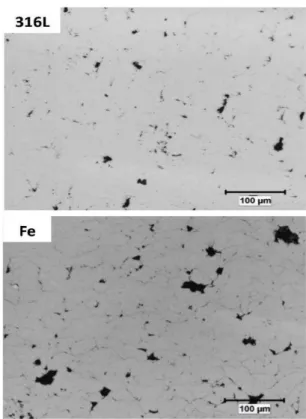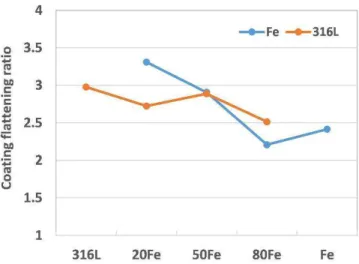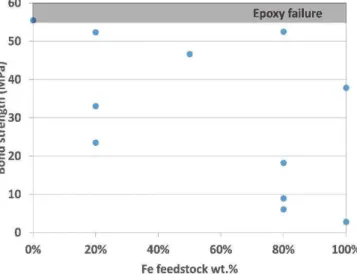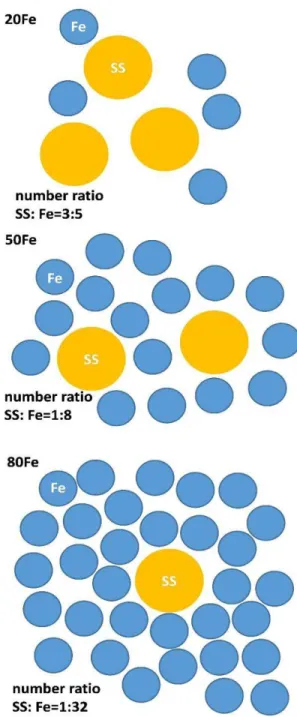Publisher’s version / Version de l'éditeur:
Proceedings of International Thermal Spray Conference 2018, 2018-05
READ THESE TERMS AND CONDITIONS CAREFULLY BEFORE USING THIS WEBSITE. https://nrc-publications.canada.ca/eng/copyright
Vous avez des questions? Nous pouvons vous aider. Pour communiquer directement avec un auteur, consultez la première page de la revue dans laquelle son article a été publié afin de trouver ses coordonnées. Si vous n’arrivez pas à les repérer, communiquez avec nous à PublicationsArchive-ArchivesPublications@nrc-cnrc.gc.ca.
Questions? Contact the NRC Publications Archive team at
PublicationsArchive-ArchivesPublications@nrc-cnrc.gc.ca. If you wish to email the authors directly, please see the first page of the publication for their contact information.
NRC Publications Archive
Archives des publications du CNRC
This publication could be one of several versions: author’s original, accepted manuscript or the publisher’s version. / La version de cette publication peut être l’une des suivantes : la version prépublication de l’auteur, la version acceptée du manuscrit ou la version de l’éditeur.
Access and use of this website and the material on it are subject to the Terms and Conditions set forth at
Effects of feedstock mixing composition on the cold sprayability of
bimodal size 316L/Fe powder mixtures
Chu, Xin; Che, Hanqing; Yue, Stephen; Vo, Phuong
https://publications-cnrc.canada.ca/fra/droits
L’accès à ce site Web et l’utilisation de son contenu sont assujettis aux conditions présentées dans le site LISEZ CES CONDITIONS ATTENTIVEMENT AVANT D’UTILISER CE SITE WEB.
NRC Publications Record / Notice d'Archives des publications de CNRC:
https://nrc-publications.canada.ca/eng/view/object/?id=6a97792d-63e8-4e12-9e56-1d3c1e60b29a https://publications-cnrc.canada.ca/fra/voir/objet/?id=6a97792d-63e8-4e12-9e56-1d3c1e60b29a
Effects of Feedstock Mixing Composition on the Cold
Sprayability of Bimodal Size 316L/Fe Powder Mixtures
Xin Chu, Hanqing Che, and Stephen Yue
Dept. of Mining and Materials Engineering, McGill University, Montreal, Quebec, Canada
Phuong Vo
National Research Council Canada, Boucherville, Quebec, Canada
Abstract
In this study, a 43 μm 316L stainless steel and a 23 μm commercial purity Fe feedstocks were used. The following coatings were made by cold spray: single component 316L, Fe, and their binary composites with nominal compositions of 20 wt.% Fe (20Fe), 50 wt.% Fe (50Fe) and 80 wt.% Fe (80Fe). The coatings were characterized (microstructure, flattening ratio, composition) and the cold sprayability metrics (DE, porosity, bond strength) were analyzed. Results show that the single component 316L coating has a much better DE and bond strength, and a slightly lower porosity as compared with the Fe coating. Whereas all the composite coatings have the similar bond strength. Moreover, the 20Fe coating features the highest porosity and the lowest DE; 50Fe coating features the lowest porosity; and the 80Fe coating features the highest DE. To indicate the feedstock mixture composition, in addition to the routine approach such as weight or volume fraction, the particle number ratio of the large/small components, which is defined as the ratio of the numbers of the component particles in a mixture estimated by the mean particle size, was calculated. Using this metric, the effects of the feedstock mixing composition on the cold sprayability of bimodal size 316L/Fe powder mixtures can be better explained.
Introduction
In the powder metallurgy practice, there is often a desire to mix powders of varying sizes to improve the packing efficiency. Some typical examples can be found in the fields of powder injection molding, where it is beneficial to increase packing density of the powder bed and also lower the powder cost by replacing some proportions of the mono-sized small powders with large ones. Cold spray is one type of highly kinetic powder consolidation process. Although the optimal sprayable feedstock size range is relatively narrow in cold spray (10 to 45 μm), still there are a few literature documenting the effects of using multimodal-sized feedstocks on the mixture cold sprayability. Maev et al. [1] observed that the DE of the ternary mixture 0.5W+0.25Al+0.25Zn is higher than 0.5Ti+0.25Al+0.25Zn under the same cold spray conditions. It was concluded that the increased mixture DE by replacing Ti
with W is due to the higher kinetic energy of tungsten heavy particles, which resulted in a higher degree of conversion of plastic work into heat and stored energy to facilitate deposition. Spencer et al. [2] discovered that coatings fabricated using mixed particle size distributions can exhibit similar coating density to those coatings fabricated by fine particles alone, but without any processing difficulties of fine particles such as inconsistent feeding or nozzle fouling. Li et al. [3] investigated the deposition of mixtures of sprayable powder (Ti or Ti6Al4V) and large shot peening particles (d0.5=155.7 μm). They observed that the coating density and microhardness will be significantly increased with increasing ratio of the shot peening particles up to 70 vol.%; whereas the mixture DE only exhibits a slight decrease. Yue et al. [4] discovered that by adding 20 wt.% of large tantalum powder into a matrix of 80 wt.% of small tantalum powder, the mixture DE will outnumber the DE of the small tantalum powder alone by 20%. To sum up, a few experiments have phenomenologically validated the use of bimodal-sized feedstock mixtures to improve cold sprayability (e.g. porosity, DE) as compared with a mono-sized feedstock. However, in literature, there is relatively few studies reporting the “composition-cold sprayability” relationship of the bimodal size mixtures.
The aim of this work is to investigate the cold sprayability of bimodal size powder mixtures as a function of the feedstock mixing composition. In this work, bimodal size powder mixtures of 316L stainless steel and commercial purity Fe were investigated. Coatings of the single component 316L, Fe, and the binary composites with three nominal compositions (20Fe, 50Fe, 80Fe) were made by cold spray. The as-sprayed coatings were characterized and the cold sprayability was discussed as a function of the feedstock mixing composition.
Materials and Methods
The 316L stainless steel and commercial purity Fe feedstock powders used in this study were gas atomized powders provided by Sandvik Osprey Limited (Neath Port Talbot, UK). The chemical compositions of the powders are shown in Table 1. The SEM images of the feedstocks are shown in Fig. 1. Information regarding the feedstock is shown in Table 2. The
316L powder used is about twice the size of the Fe, and the microhardness of the Fe is slightly higher than the 316L.
Table 1: Chemical compositions of 316L and Fe powders (in wt. %).
Powder Fe Cr Ni Mo Mn Si C
316L 68.7 16.4 10.9 2.3 1.4 0.3 0.01 Fe 99.3 0.07 0.1 0.02 0.4 0.1 0.03
Figure 1: SEM images and size distributions of the feedstock powders.
Table 2: Information regarding the feedstock powders.
Powder Supplier Shape Size HV
316L Sandvik Spherical 43 226.4
Fe Sandvik Spherical 23 287.7
Spraying was performed at the McGill-NRC cold spray facility, located at the National Research Council Canada, Boucherville, using a KINETIKS® 4000 cold spray system (Sulzer Metco, Westbury, NY) with a MOC24 nozzle. The process parameters were set at a gas preheating temperature of 700 °C, a gas pressure of 4 MPa, and a stand-off distance of 80 mm. The feedstocks were sprayed at a feed rate of 19.5 to 24.1 g/min and an approximate coating thickness of 2 mm was obtained for each sample. Coatings with nominal compositions of 100 wt.% 316L (316L), 316L-20 wt.% Fe (20Fe), 316L-50 wt.% Fe (50Fe), 316L-80 wt.% Fe (80Fe) and 100 wt.% Fe (Fe) were deposited.
Prior to spraying, the feedstocks were mixed in a rolling mixer. The Al 6061 plates with a dimension of 100 mm×100 mm×3 mm were used as substrates and were blasted with 24 grit alumina to remove the scale and roughen the surface to promote adhesion. After spraying, the DE was measured as the mass gain of the substrate divided by the total mass of spray material fed during the time that the gun was over the substrate. The coating cross-sections were observed using a light optical microscope (LOM). The composite coating compositions were determined through chemical analyses by ICP 6000 series optical emission spectroscopy (OES). The bond strength of the as-sprayed coatings were measured following the ASTM C633-01 standard.
Results
1. Coating microstructureThe cross-sectional microstructure of the single component 316L and Fe coatings are shown in Fig. 2. In general, the porosity levels in both coatings are low, although the Fe exhibits a higher amount of porosity than 316L. Regarding the intersplat bonding conditions, the Fe/Fe interparticle boundaries appear to be more clearly delineated, as compared with the 316L/316L interparticle boundaries which have a much better optical characteristic.
Figure 2: Optical cross-sectional microstructure of the 316L and Fe single component coatings.
The cross-sectional microstructure of the composite 316L/Fe coatings is shown in Fig. 3. For 20Fe, in general, the intersplat bonding condition in 20Fe is poor, as a few cracks can be seen to be present along the mixed and non-mixed interfaces. Also, a certain amount of porosity is observed in the coating.
Specifically, at the mixed 316L/Fe interfaces, a few inter-lamellar cracks are observed to preferentially locate on the “top” of Fe and the “bottom” of 316L (arrowed in red). These inter-lamellar cracks were discussed in a previous work to indicate a poor bonding/deposition behavior of 316L impacting on Fe [6]. For 50Fe, the cross-sectional images shows that the intersplat boundaries in 50Fe have much better optical characteristics as compared with those in 20Fe, and the preferentially located mixed interface inter-lamellar cracks observed in 20Fe are also absent in 50Fe. Also, the cold sprayed 50Fe coating is much denser than 20Fe. For 80Fe, a good optical characteristic of the mixed 316L/Fe interfaces in 80Fe with no presence of preferentially located inter-lamellar cracks is observed. Moreover, it is also observed in the 80Fe cross-section that, the deposited SS particles appear to exhibit an “umbrella” shape (arrowed in red) and the underlying Fe matrix particles have visible intersplat boundaries. It is believed that these poorly bonded Fe matrix particles are retained by the large 316L particles during cold spray deposition. Further discussions regarding the effect of the large/heavy particles on the mixture DE will be presented in discussion section.
Figure 3: Optical cross-sectional microstructure of the composite coatings.
Flattening ratio (FR) is calculated as the width over height of a deformed particle and it indicates the degree of particle deformation in the coatings. Since the 316L and Fe powders differ significantly regarding the crystalline structure and particle size, distinct deformation behaviors of the two powders are to be expected in the coatings. The average FR of each powder is plotted in Fig. 4.
For single component coatings, 316L powder has a higher FR than Fe powder in the coatings (3 vs 2.4). The possible reasons for the difference in FR of 316L and Fe powders can be due to the softer and easier plastic flow of 316L than Fe. In the 20Fe coatings, the FR of Fe powder (3.3) is higher than that of the 316L powder (2.7). This is possibly due to the impact of large 316L powder with high kinetic energy, thus the small Fe powder is forced to deform more in the coatings. In the 80Fe mixed coatings, the FR of both powders decrease but 316L powder exhibits a larger degree of deformation than Fe powder (2.5 vs 2.2), which possibly results from the continuous tamping of the relatively hard Fe powder in large amount. In the 50Fe mixed coating, both the 316L and Fe components display the same FR value of 2.8, which might be due to a combination of the above-mentioned mechanisms.
Figure 4: Coating flattening ratio of the as-sprayed coatings.
2. Cold sprayability
The DE of the 316L/Fe feedstock powders is shown in Fig. 5. For single component powders, it can be seen that the DE of 316L is more than twice that of the Fe (72% vs 32%). This result is correlated with the observation in Fig. 3 of a better intersplat bonding characteristic in the 316L coating than the Fe coating. Whereas for the mixed powders, with increasing the feedstock Fe fraction, the mixture DE continues to increase. Comparing the two mixture DE extremes (20Fe, 80Fe) with the single component feedstock DE (316L, Fe), the low Fe mixture with a 316L matrix (20Fe) actually exhibits a significantly lower DE as compared with the single component 316L DE (72% vs 42%); whereas the high Fe mixture with a Fe matrix (80Fe) instead has an evidently higher DE than the single component
Fe (66% vs 32%). As the Fe is a worse DE component compared with the 316L, the normal expectation of the mixture DE is that it should follow a monotonic decrease from the single component 316L end to the single component Fe end. However, the measured DE results refute such an expectation and show a reverse trend.
Figure 5: DE of the feedstock powders.
The porosity of cold sprayed coatings are a result of the incomplete conformal deformation of the particles. As shown in Fig. 6, the porosity levels of single component coatings are found to correlate with the FR values; whereas for the mixed coatings, there is a much better correlation with the difference in FR values of the feedstock components. The coating of 20Fe has a larger FR difference (0.6) between the 316L and Fe powders, hence the dissimilar particle deformation creates more gaps between each powder and thus leads to the highest coating porosity of 4.5%. While in 80Fe coating, the FR difference is smaller (0.3), therefore, the porosity level of 2% is also lower than 20Fe. As well, in 50Fe coating as both the 316L and Fe components have the maximum contact with each other and thus their deformation levels are seen to be similar (same FR), thus the coating yields the lowest porosity.
Figure 6: Porosity of as-sprayed coatings.
Bond strength of the as-sprayed coatings are shown in Fig. 7. The 316L coating is seen to exhibit the epoxy failure, indicating
a higher cohesive and adhesive strength of the coating than the epoxy strength of about 53 MPa. With a higher Fe content in the starting powders, the fracture type switches to the cohesive failure. The coating bond strength exhibits a very wide range of cohesive strength values with minima between 2-10 MPa, although the maximum values plateau at around 46.7 to 52.5 MPa regardless of the coating composition. The bond strength of the composite coating is significantly higher than the single component Fe coating, which has a value of 37.8 MPa. Based on the previous discussions, it is generally considered that the “316L on Fe” interfaces and Fe/Fe interfaces (low bond strength in Fig. 7) are the “weak spots” in the composite coatings during the pull-off tests. This explains a lower cohesive strength of 20Fe coating as compared with the single component 316L coating. Thus, the normal expectation of the composite coating bond strength is that it should follow a monotonic decreasing trend with increasing the poor bonding component Fe. But again, the plateau of the coating bond strength at the composite region implies there is a strong mixing powder effect of the bimodal size mixtures during cold spray deposition.
Figure 7: Bond strength of as-sprayed coatings.
Discussion
1. Effects of mixing on cold sprayabilityBased on the previous results, it can be seen that the cold spray deposition of bimodal size 316L/Fe powder mixtures gives the unpredictable coating microstructure as well as the cold sprayability. Explanations of the mixed powder cold sprayability metrics using the common approach e.g. Rule of Mixtures (ROM) appear to be difficult. This motivates us to investigate the mixed powder cold spray build-up process on the basis of the single particle impacts with the consideration of the particle size difference. A simple concept namely, particle number ratio, which is defined as the ratio of the numbers of component particles in a mixture estimated by the mean particle size, is introduced. Based on this concept, the hypothesized
schematic of the respective multiple particle arrangement prior to impacting on the substrate can be calculated and is presented in Fig. 8. The effects of mixing powders on the cold sprayability of the mixed powders are then discussed accordingly.
Figure 8: The multiple particle arrangement of the bimodal size feedstock mixture prior to impact.
For 20Fe, the relative particle number ratio of the component powder in 20Fe is SS:Fe=3:5, where the initial major component SS (80% in weight fraction) becomes a relatively equal composition component in the mixture (in particle number ratio). It is thus expected there will be significant amount of SS/SS, SS/Fe, and Fe/Fe particle interaction simultaneously occurring upon deposition. Assuming each component feedstock would fulfill relatively similar amounts of impacts during deposition, the composite coating build-up kinetics (e.g. DE) can be related to the deposition behavior
between the feedstock components. It is observed in Fig. 3 that the 316L on Fe impact scenario will generate very poor bonding/deposition behavior (preferentially located lateral cracks on top of Fe and bottom of 316L), which would prefer to rebound rather than deposit or act as “weak spots” in the coating. Also, the degree of deformation between the large SS and small Fe upon impact is distinct (see different component FR in Fig. 4) and generates inhomogeneity in the coating. Thus, it is believed these factors (poor bonding/deposition behavior of 316L on Fe, and deformation mismatch between large/small components) would result in a sudden drop in DE and bond strength, as well as the drastic increase in porosity, as compared with the single component 316L coating.
For 50Fe, the particle number ratio is SS:Fe=1:8, where one large SS particle can be considered to be surrounded by eight small Fe particles in the mixture prior to impact. This packing structure is analogous to the atomic packing in BCC crystals, where the large SS can be seen as the center atom in unit cells and the eight small Fe particles occupy eight corner sites to realize a coordination number of 8. It is believed that a close packing and a sufficient interaction between the large/small feedstock components will be achieved in this powder mixture composition during deposition. As seen in Fig. 4, the SS FR experiences a slight increase and merges with Fe FR with a value of 2.8. This indicates the occurrence of a homogeneous deformation behavior between the large/small components during deposition. The increase in large/small feedstock interaction is believed to benefit the intersplat bonding, as seen in Fig. 3 by the excellent optical characteristics of the intersplat boundaries. Moreover, compared with 20Fe, there is a decrease in the relative number ratio of the large/heavy SS feedstock; thus it is believed that there is a lower number of the poorly deposited 316L on Fe impacts to occur in 50Fe than in 20Fe during deposition. Due to these above two effects, i.e. increase in large/small feedstock interaction and reduce in occurrence of the poorly deposited 316L on Fe impacts, the 50Fe mixture will experience an increase in DE, a decrease in porosity, and plateau in bond strength despite a higher Fe wt.%, as compared with the 20Fe.
For 80Fe, the particle number ratio is SS:Fe=1:32. The large SS is expected to be surrounded by a “sea” of small Fe particles in this mixture prior to impact, whereas the inner layer can still form a BCC crystal type packing to accommodate the large/small particle interaction during deposition. Similarly as in 50Fe, the inner BCC-type packing is believed to benefit the intersplat bonding, especially for the 316L on Fe impacts, as can be seen in Fig. 3 by a good optical characteristic of the mixed 316L/Fe interfaces in 80Fe free of preferentially located inter-lamellar cracks. Since the peripheral small Fe particles cannot have the direct interaction with the large SS particles, this generates a certain deformation mismatch (slightly different FR of 80Fe in Fig. 4) between the inner layer and the outer layer during deposition, which results in a slightly higher porosity level as compared with the 50Fe (2% vs 1.5%). As compared with 50Fe, there is a further increase in the particle number ratio of the feedstock Fe. Thus, the number of the poorly deposited 316L on Fe impacts during deposition continues to decrease. Comparing the Fe FR at 80Fe and single component Fe coating, it is noticed that the former mixture with
the large/heavy SS inclusion exhibits a similar or even slightly lower FR compared with the single component Fe deposition (2.2 vs 2.4). The tamping effect exerted by the large/heavy particles is generally considered to result in the forced deformation of the underlying particle layers. The lower Fe FR in the composite coating implies that, apart from tamping, the inclusion of the large/heavy particles might play an effect to reduce the impact velocity of the overall mixture or to capture the fast moving small particles during flight for codeposition. It is believed that the small Fe particles at the periphery of the cluster having a high velocity and quantity are believed to form a “continuous network” during deposition to trap the large SS core particles from rebounding off when they deposit on Fe (see the severely flattened SS particle in red circle, 80Fe in Fig. 3). Moreover, the “umbrella” shape of the deposited SS (arrowed in red, Fig. 3) and the poorly bonded undying Fe matrix particles in 80Fe imply that the large SS particles might play an effect to capture the rebounded small particles for codeposition. To sum up, it is believed the drastic increase in mixture DE from 50Fe (48%) to 80Fe (66%) is due to the combined effects of the lowered occurrence of the poorly deposited 316L on Fe impacts, the retention of SS by the “continuous network” of small and fast Fe particles, and the “capturing” of rebounded Fe by the large SS particles.
Conclusion
In this study, single component 316L stainless steel and commercial purity Fe powders, as well as their binary mixtures (20Fe, 50Fe and 80Fe), were deposited by cold spray. The coating microstructure of the single component and composite coatings were presented and the cold sprayability metrics (DE, porosity, and bond strength) were reported as well. To indicate the initial feedstock composition of the bimodal size mixtures, the particle number ratio, which is defined as the ratio of the numbers of the component particles in a mixture estimated by the mean particle size, was calculated in addition to the traditional approach such as weight (or volume) fraction. Using this metric, the effect of the feedstock mixing composition on the cold sprayability of bimodal size 316L/Fe powder mixtures can be better explained.
Acknowledgments
The authors would like to acknowledge the McGill Engineering Doctoral Awards (MEDA) and Natural Sciences and Engineering Research Council of Canada (NSERC) for the financial support.
References
[1] R. G. Maev and V. Leshchynsky, "Air gas dynamic spraying of powder mixtures: theory and application," J.
Therm. Spray Technol., Vol. 15 (2006), pp. 198-205.
[2] K. Spencer and M. X. Zhang, "Optimisation of stainless steel cold spray coatings using mixed particle size distributions," Surf. Coat. Technol., Vol. 205 (1995), pp. 5135-5140.
[3] X.-T. Luo, Y.-K. Wei, Y. Wang, and C.-J. Li, "Microstructure and mechanical property of Ti and Ti6Al4V prepared by an in-situ shot peening assisted cold spraying," Mater. Des., Vol. 85 (2015), pp. 527-533. [4] S. Yue, W. Wong, H. Aydin, R. Mongrain, R. Barua, P.
Vo, et al., "Improving cold sprayability: mixed metal powders," Proc Int’l Thermal Spray Conference 2015, Long Beach, CA, May 2015, pp. 473-478.
[5] H. Aydin, M. Alomair, W. Wong, P. Vo, and S. Yue, "Cold Sprayability of Mixed Commercial Purity Ti Plus Ti6Al4V Metal Powders," J. Therm. Spray Technol., Vol. 26 (2017), pp. 1-11.
[6] X. Chu, H. Che, P. Vo, R. Chakrabarty, B. Sun, J. Song, et al., "Understanding the cold spray deposition efficiencies of 316L/Fe mixed powders by performing splat tests onto as-polished coatings," Surf. Coat. Technol., Vol. 324 (2017), pp. 353-360.
[7] R. Barua, "Study of the structural properties and control of degradation rate for biodegradable metallic stents using cold spray," PhD thesis, Department of Mechanical Engineering, McGill University, 2015.



